Semitransparent Polymer Solar Cells Based on Liquid Crystal Reflectors
Abstract
The effects of liquid crystal (LC) reflectors on semitransparent polymer solar cells (PSCs) were investigated in this paper. By improving the cathode, we manufactured semitransparent PSCs based on the conventional PSCs. We then incorporated the LC reflector into the semitransparent PSCs, which increased the power conversion efficiency (PCE) from 2.11% to 2.71%. Subsequently adjusting the concentration and spinning speed of the active layer material changed its thickness. The maximum light absorption for the active layer was obtained using the optimum thickness, and the PCE eventually reached 3.01%. These results provide a reference for selecting LC reflectors that are suitable for different active layer materials to improve the PCE of semitransparent PSCs.
1. Introduction
Interest in PSCs has recently increased due to their numerous advantages, such as low fabrication cost, light weight, and flexibility [1–4]. Researchers can improve the PCE of PSCs in many ways. The PSC performance can be improved by modifying the electrodes: for example, a LiF, ZnO, or poly(ethylene oxide) (PEO) layer can be added between the active layer and cathode to modify the cathode [5–7]. Doping with metal nanoparticles is a method of increasing light absorption that has been used in the manufacturing of solar cells [8, 9]. Mixed solvents can be used to improve the solar cell performance [10]. The synthesis and use of new materials, such as polysilole(-2,6-diyl-alt-5-octylthieno[3,4-c]pyrrole-4,6-dione)(PDTSTPD), poly[[9-(1-octylnonyl)-9H-carbazole-2,7-diyl]-2,5-thiophenediyl-2,1,3-benzothiadiazole-4,7-diyl-2,5-thiophenediyl](PCDTBT), poly[2,6-(4,4-bis-(2-ethylhexyl)-4H-cyclopenta[2,1-b;3,4-b]dithiophene)-alt-4,7-(2,1,3-benzothiadiazole)](PCPDTBT), and poly{[4,8-bis-(2-ethyl-hexyl-thiophene-5-yl)-benzo[1,2-b:4,5-b′]dithiophene-2,6-diyl]-alt-[2-(2′-ethyl-hexanoyl)-thieno[3,4-b]thiophen-4,6-diyl]}(PBDTTT-C-T), can also improve the PSC efficiency [11–13]. Because conventional solar cells are not generally transparent, they seriously affect the collection of light indoors when installed on building surfaces. Therefore, the transparent solar cells are another important research topic. In 2011, Jan et al. researched semitransparent tandem organic solar cells that contained complementary absorber materials with an average transmission of 24% in the visible range [14]. In 2012, Kung-Shih Chen et al. researched inverted semitransparent PSCs with a 6% PCE and 25% average visible transmittance [15]. Recently, Sharp unveiled a semitransparent silicon-based solar panel that is capable of harnessing energy from the sun while still allowing some light to pass through. These black photovoltaic panels are 1.37 meters by 0.98 meters and only 0.01 meters thick. Each panel is rated at 6.8 percent/95 watt maximum efficiency.
2. Experiments and Methods
In this paper, an LC reflector was used to enhance selective absorption by the PSC. This LC reflector selectively reflects incident light passing through the active layer to be absorbed again. This process increases the photoabsorption with the condition that the reflected light must generally match the absorption spectrum of the active layer [16].
Initially, we performed experiments to obtain an absorption spectrum for the active layer materials. Poly(3-hexylthiophene) (P3HT) and [6,6]-phenyl C71 butyric acid methyl ester (PC71BM) (purchased from the Lumtec company) were used as the active layer materials. They were dissolved in a chlorobenzene (CB)/chloroform (CF) (Vol/Vol = 3/1) mixture with a weight ratio of 1 : 1 and a concentration of 20 mg/mL [17] and subsequently spin-coated at 1500 rpm onto clean glass to form the active layer, which was annealed at 130°C for 20 min. The UV-vis absorption spectrum of the active layer was measured using a spectrophotometer (Hitachi U-4100) as shown in Figure 1.
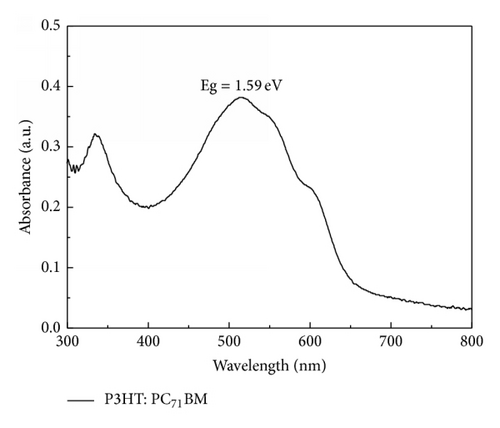
Figure 1 shows the main absorption band for P3HT : PC71BM lies between 480 nm and 560 nm. To improve the PCE of this PSC, the centre spectral position of the LC reflection band should coincide with the absorption band for the active layer. Two LCs with very special properties, LC242 and LC756, were selected. LC242 is a totipotent nematic LC that can act as a compensation film when used with the polymer. LC756 is a chiral nematic LC that not only acts as a compensation film but also has an optical effect. The dominant reflection wavelengths for mixtures of LC242 and LC756 in different mass ratios are given in Table 1 [18].
| LC242 (wt.%) | LC756 (wt.%) | Centre reflection wavelength (nm) |
|---|---|---|
| 96.89 | 3.11 | 745 |
| 96.42 | 3.58 | 682 |
| 95.53 | 4.47 | 523 |
| 95.24 | 4.76 | 490 |
| 94.95 | 5.05 | 457 |
We manufactured semitransparent PSCs based on conventional PSCs. Prepatterned ITO-coated glass with a sheet resistance of 12 Ω was used as the substrate and anode electrode. Poly(3,4-ethylenedioxythiophen-e) : poly(styrenesulphonate) (PEDOT : PSS) treated with isopropanol in a volume ratio of 5 : 1 was spin-coated onto the substrate at 3000 rpm for 30 s [19]. The P3HT : PC71BM active layer (the same as mentioned above) was spin-coated at 1500 rpm onto the prepared PEDOT : PSS layer to form a 100 nm thick active layer. The PSCs were then placed in a drying oven and annealed at 130°C for 20 min. The Al cathode was thermally evaporated in a vacuum chamber through a shadow mask.
Fabricating a semitransparent cathode is key to semitransparent PSCs. Thin metal, conductive polymer, and transparent conductive oxide layers can all be used as semitransparent cathodes [20]. To determine the effect that the Al electrode thickness had on the transparency, we created 20-, 30-, 40-, 50-, and 60-nm thick Al electrodes. The transmission spectra for the Al electrodes were measured using a spectrophotometer (Hitachi U-4100). Figure 2 shows that the transmissivity of 20 nm, 30 nm, 40 nm, and 50 nm thick Al electrodes was approximately 24%, 14%, 8%, and 5%, respectively. The transmittance decreased with increasing Al electrode thickness. A 60-nm thick Al electrode was largely opaque. Considering the light transmittance requirements, we confirmed that the Al electrode thickness was approximately 20 nm. However, a 20- to 30-nm thick Al electrode is too thin, which drastically influences the semitransparent PSCs’ PCE. We selected ZnS as an auxiliary cathode material that not only effectively collects electrons but also has a high light transmittance. The final semitransparent PSC architecture is as follows: Glass/PEDOT : PSS/P3HT : PC71BM/LiF/(Al/ZnS). The 20-nm Al and 50-nm ZnS layers acted as a semitransparent cathode. The active area of the device was 16 mm2 (4 mm × 4 mm).
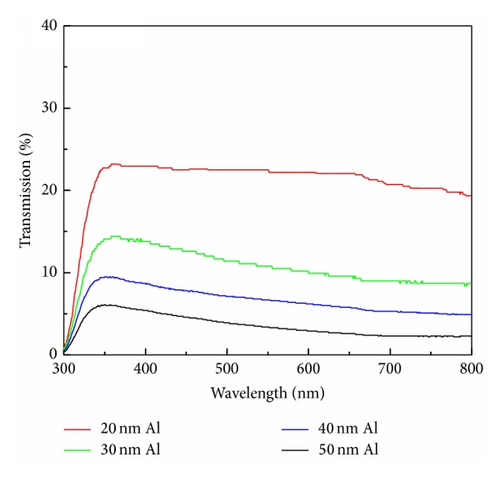
LC242 and LC756 powders were both mixed in a 95.53 : 4.47 mass ratio in xylene. The LC solution was spin-coated onto the half-wave plate and subsequently heated in a drying oven at 85°C for 20 s to enhance the LC alignment. The films were then cross-linked using a UV light source for 10 min to form a solid layer [21]. The LC film and cell were encapsulated together. A schematic representation of the semitransparent PSC with an LC reflector is shown in Figure 3.
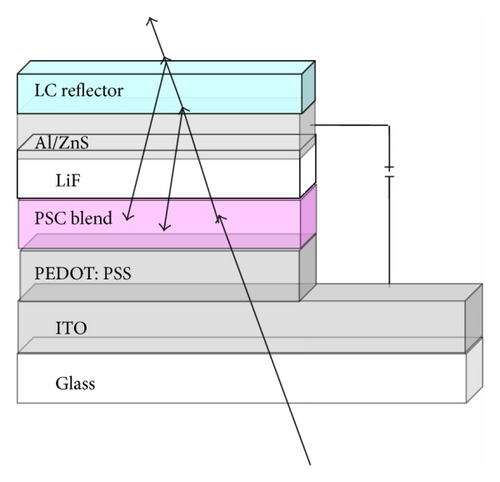
All of the thicknesses were measured using a stylus profiler (Dektak 150). The photocurrent-voltage characteristics were measured using a sun simulator AM 1.5 (100 mW/cm2, Japan, San-Ei, ELS 155 (XE)) and Keithley 2400 SourceMeter. The external quantum efficiency (EQE) was measured using the IPCE/QE/spectral response test system (Crown Tech, USA). At room temperature, the photovoltaic properties of the semitransparent polymer solar cells were measured using ITO as the anode, Al/ZnS as the cathode, and the light incidences from the anode.
3. Results and Discussion
The parameters of semitransparent PSCs both with and without the LC reflector were measured. The active layer was approximately 100 nm thick. The PSC performance parameters are shown in Table 2(a). The corresponding J-V curves were also obtained, as shown in Figure 4(a). For bulk heterojunction solar cells, the open-circuit voltage, Voc, is primarily determined by the highest occupied molecular orbital (HOMO) of the donor and the lowest unoccupied molecular orbital (LUMO) of the receptor [22]. Therefore, the Voc is almost constant. In contrast, the short circuit density, Jsc, is determined by the quantum efficiency or active layer surface morphology. After incorporating the LC reflector, the Jsc increased from 7.54 mA/cm2 to 9.27 mA/cm2. Increasing the photoabsorption increases the PCE from 2.11% to 2.71%, an improvement of over 28% relative to the reference solar cell without the LC reflector.
| Device | Jsc (mA/cm2) | Voc (V) | FF (%) | η (%) |
|---|---|---|---|---|
| Without LC reflector | 7.54 | 0.53 | 53.2 | 2.11 |
| With LC reflector | 9.27 | 0.53 | 55.6 | 2.71 |
| Device | Thickness of the active layer (nm) | Jsc (mA/cm2) | Voc (V) | FF (%) | η (%) |
|---|---|---|---|---|---|
| A | 150 | 10.3 | 0.53 | 53.1 | 2.89 |
| B | 200 | 11.2 | 0.53 | 51.0 | 3.01 |
| C | 250 | 9.2 | 0.53 | 53.5 | 2.59 |
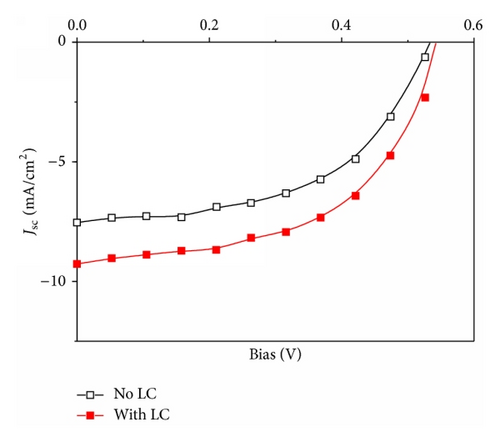
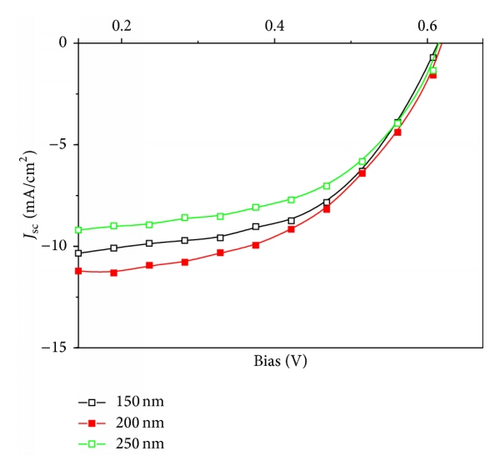
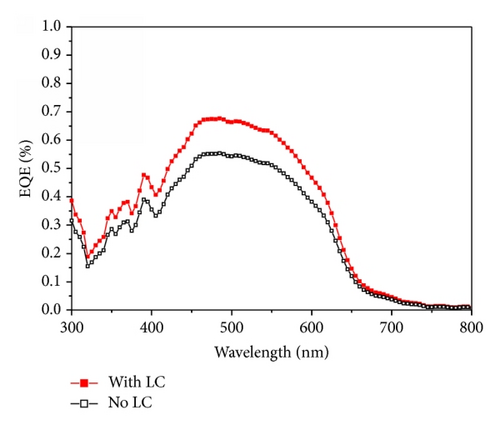
Although the best conventional PSCs are approximately 100 nm thick, perhaps more light reflected by the LC reflector should be absorbed by the active layer again. We should determine the best active layer thickness for PSCs using an LC reflector. We then fabricated three more semitransparent PSCs with LC reflectors, named A, B, and C, using the method described above. A mixed CB/CF solution (Vol/Vol = 3/1) was still used as the solvent; however, the active layer concentrations for A, B, and C were 25 mg/mL, 30 mg/mL, and 35 mg/mL, respectively. Active layer thicknesses of 150 nm, 200 nm, and 250 nm were obtained for A, B, and C, respectively. The performance parameters for PSCs with LC reflectors are shown in Table 2(b), and the corresponding J-V curves were obtained as shown in Figure 4(b). Table 2(b) directly verified the preliminary assumption that the initial thickness (100 nm) is insufficient. A concentration of 30 mg/mL and thickness of 200 nm are best for PSCs with LC reflectors. Thicknesses above or below 200 nm adversely affect the semitransparent PSCs.
4. Conclusions
In summary, we manufactured a semitransparent PSC based on conventional PSCs by improving the cathode. The active layer thickness was still approximately 100 nm. We then incorporate the LC reflectors into the semitransparent PSCs, and the incident light that passes through the active layer is selectively reflected and absorbed by the active layer again. The PCE increased from 2.11% to 2.71%, an improvement of over 28% compared with a reference solar cell without an LC reflector. More light reflected by the LC reflector should be absorbed by the active layer thin film again compared to the conventional PSCs. Therefore, we researched the optimum thickness for the semitransparent PSC active layer when using an LC reflector. When the active layer thickness is approximately 200 nm, the Jsc increased from 9.27 mA/cm2 to 11.2 mA/cm2. The PCE of the semitransparent PSC with an LC reflector reached 3.01%.
Conflict of Interests
The authors declare that there is no conflict of interests regarding the publication of this paper.
Acknowledgments
The authors are grateful to the Natural Science Foundation of Hebei Province (Grant nos. F2010000306, F2012201089, and A2011201008) and Hebei Province Department of Education Fund (ZH 2011205) for funding this work.




